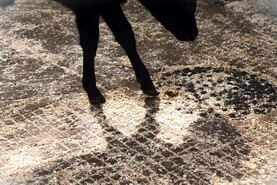Breeding: Many farms are gearing up for breeding in the next few weeks. For farms starting to calve in mid-February 2020, cows will need to be bred in the first week of May 2019. If you are using AI cows, they should be tail painted at this stage and heats should be recorded for ease of detection three weeks later. Tail painting will also mean you can investigate cows which haven’t been in heat before breeding commences. Some may require a wash out or have other issues. Time is of the essence as a suckler cow can have a non-cycling period after calving for as long as 60 days, which leaves a short time to get cows back in calf inside 365 days. Some farmers suck calves twice a day to break the bond and bring cows into heat quicker. While this sounds like a huge amount of work, when cows and calves get use to the system, it can work quite well.
When breeding does commence, make sure to keep accurate records, especially if you are using a stock bull to monitor fertility. Have you got a plan B if a stock bull gets hurt and is unable to serve cows?
Worm control: I have been asked a few questions about fluke and worm control at turnout. With fluke, if the appropriate product was used during the housing period, there shouldn’t be an issue. New infection can occur if grazing very wet areas of the farm and stock should be monitored for any signs of fluke infection.
For gutworms and lungworms, we need to be careful around the use of dosing products to avoid resistance developing on farms. Adult cattle should have sufficient immunity built up from previous grazing, second-season grazers may need a dose if sufficient immunity hasn’t built up. Faecal sampling should be used to determine if dosing is needed. With calves, suckler calves and dairy calves need to be treated differently. Suckler calves are not as disposed to worm infection as dairy x calves. Dairy calves should get a dose three weeks after turnout and again at appropriate intervals during the year.
If faecal samples show greater than 200 eggs per gram, a dose is needed. At the start of each grazing season, following housing, cattle may have very little or no immunity to lungworm and are susceptible to new infections.
Silage budget: While it may be at the back of many people’s thoughts, now is probably the right time to do a silage budget for winter 2019/20. Completing a budget next November, when not much can be done about it, is little use. Completing one now will mean you can take action over the coming months to boost supply. Use a few quick guidelines. Suckler cows: 1.4 t/month; store cattle: 1.3 t/month and weanlings; 0.7 t/month. First cut yield will generally yield 7-10t/ac and second cut will yield 5-7t/ac.
Have you got enough area closed up for first cut silage? If you are stocked at 2.3 L.U/ha it’s recommended that you should close 50% of the farm for first cut and 20% for second cut. We are entering into the highest grass growth period of the year, make sure you capitalise on it.






 This is a subscriber-only article
This is a subscriber-only article









SHARING OPTIONS: